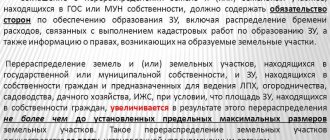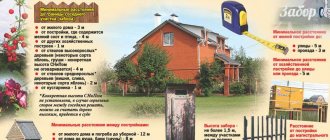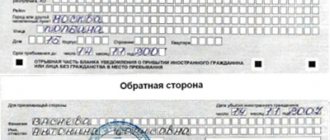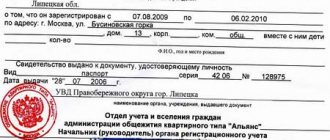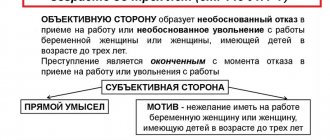Structure of land resources of the Russian Federation
Land resources refers to all land (i.e. the entire territory) within certain boundaries. The land resources of the Russian Federation are its entire territory, i.e. all land (including water-covered land) within the state borders of the country. Although individual parts of land resources at any given moment may be objects of ownership and use of different entities,
in general they are a single natural object. And as such, they have various natural qualities and properties that are of national economic interest (soil fertility, forest cover, water cover, mineral content, etc.), which in connection with this it is advisable to use in a certain way, i.e. for national economic purposes.
From this point of view, land resources are divided into seven target categories enshrined in land legislation (Article 7 of the Land Code of the Russian Federation), namely:
- Agricultural land.
- Lands of populated areas.
- Lands of industry, energy, transport, communications, radio broadcasting, television, computer science, lands for space activities, lands of defense, security and other special purposes.
- Lands of specially protected territories and objects (environmental, recreational, health and historical and cultural purposes).
- Forest fund lands.
- Water fund lands.
- Reserve lands.
In accordance with the main intended purpose of the mentioned parts of land resources, land legislation also established the legal regime for their use in the national economy.
Agricultural lands include land plots that are used or, due to their natural qualities, suitable for use in agriculture, i.e. for the production of agricultural products.
Lands of populated areas are considered to be lands located within the administrative boundaries of various settlements (cities, towns, rural settlements). The main purpose of these lands is to meet the urban planning needs of these settlements.
Lands of industry, energy, transport, communications, radio broadcasting, television, computer science, lands for space activities, defense, security and other special purposes are areas of the land fund provided to legal entities or individuals for the implementation of special tasks in industry, transport, in energy and other sectors of the national economy. The main purpose of land in these areas of the national economy is to serve as an operational basis for the location and functioning of industrial and other enterprises and facilities.
Forest fund lands are lands covered with forests, as well as those not covered by them, but provided or intended for forestry. The forest is a very valuable natural raw material for industry, is an energy source, a place of recreation for citizens, plays the role of “lungs” for populated areas, etc. and therefore needs to establish a special legal regime for its use.
Water fund lands include lands occupied by water bodies, water protection zones, hydraulic engineering and other water management structures, as well as lands along the banks of reservoirs (coastal strips) necessary for their maintenance. Their main purpose is to satisfy the drinking, household, health and other needs of the population, as well as water management, environmental, industrial, energy, transport, fisheries and other needs.
The category of specially protected areas includes lands of environmental, health, recreational and historical and cultural purposes, which have the status of specially protected areas, due to their specific role and special significance in the life of society. They serve to satisfy the spiritual, biological, aesthetic and other needs of citizens.
Reserve lands are considered all plots that are not provided for ownership or use by individuals or legal entities or seized from them on the grounds provided for by law, with the exception of a specially formed land redistribution fund.
The target category determines only the main, general purpose of the lands assigned to it. The specific use of land plots within target categories may vary significantly according to practical feasibility.
This sign of delimitation of lands of target categories is specified in the form of their permitted use, which refers to the nature, types and methods of land use. In this case, certain restrictions or prohibitions may be provided, the observance of which is mandatory. Thus, within water protection zones and on agricultural lands, it is prohibited to use pesticides, plow the soil, grazing livestock, and on lands subject to erosion processes, the use of agricultural technology that stimulates the development of these processes is limited, etc.
The legislation (Article 7 of the Land Code of the Russian Federation) establishes that the legal regime of lands is determined by their belonging to one or another target category and permitted use in accordance with territorial zoning. Territorial zoning is the establishment of boundaries of territories (zones), within which lands have properties and qualities necessary and sufficient for certain economic activities.
Another classification feature of the land fund is the natural-historical and economic state of its individual parts, which is called land. Land plots are understood as plots of land (massifs) systematically used for certain economic purposes and having qualitative differences of a natural-historical nature. All land is divided into two groups: agricultural, i.e. systematically used for the production of agricultural products (they are also called productive lands), and non-agricultural lands, i.e. lands not included in agricultural circulation. Agricultural lands include: arable land, hayfields, pastures, areas occupied by perennial fruit plants. Non-agricultural land - all others (areas occupied by forests, bushes, swamps, buildings, roads, etc.).
Both agricultural and non-agricultural lands are divided into subtypes, most often according to their natural state or method of use: arable land, waterlogged, irrigated; the hayfield is swampy, bushy, and tussocked; forested pasture, etc.
The qualitative state of productive lands is characterized by their level of fertility, which depends on the type of soil (chernozems, podzolized soils, etc.) and their physicochemical composition (clayey, sandy loam, sandy, etc.). An indicator of land fertility is economic assessment points, which are conventional numbers expressed as a percentage of the highest productivity of lands in a given group: 100, 90, 80, etc. points. To evaluate lands involved in civil circulation, there is another criterion - the cadastral value of land plots, which is their monetary value.
Primary establishment of the category of land fund
If the category of land is indicated not in the documents of the state cadastre of real estate, but in the title documents for land plots or documents certifying rights to land, amendments to the documents of the state cadastre of real estate and in the records of the Unified State Register of Rights to Real Estate and Transactions with it is carried out on the basis of title documents for land plots or documents certifying rights to land, at the request of land owners.
If there are contradictions between the data on the ownership of land plots as lands of a certain category, specified in the documents of the state cadastre of real estate, and the data specified in the title documents for land plots or documents certifying rights to land, the assignment of land plots to lands of a certain category is carried out on based on the data specified in the title documents for land plots or documents certifying rights to land, according to applications from land plot holders.
If the category of land is not indicated in the documents of the state cadastre of real estate, title documents for a land plot or documents certifying rights to land, a regulatory legal act of a local government body is adopted on classifying the land plot as land of a certain category depending on the purpose of use for which it was provided.
Land plots located within the boundaries of settlements are subject to classification as lands of settlements, and outside the boundaries of settlements - to a certain category of land, depending on the documented actual use of the land plot.
Before the delimitation of state ownership of land, the transfer of state-owned lands or land plots as part of such lands from one category to another is carried out by the Government of the Russian Federation when transferring:
1) lands or land plots necessary for federal needs;
2) lands or land plots within such lands to establish or change the boundaries of the federal cities of Moscow and St. Petersburg.
In other cases, before the delimitation of state ownership of land, the transfer of state-owned lands or land plots within such lands from one category to another is carried out by executive authorities of the constituent entities of the Russian Federation or, in cases established by the laws of the constituent entities of the Russian Federation, by local government bodies.
Before the delimitation of state ownership of land, the classification of state-owned lands or land plots as part of such lands to the lands of settlements, the boundaries of which were established before the entry into force of the Federal Law “On the transfer of lands or land plots from one category to another”, is carried out by the authorities local government without the consent of the land owners.
Methods and principles of land law
The method of legal regulation in land law is a set of imperative and dispositive methods of influence of the state on the behavior of people, determined by the political, social, economic features of land relations, objective laws of society and nature. The method of land law represents ways and techniques of influencing people's behavior that correspond to the nature and nature of the land as a unique natural resource vital to all citizens. The method of influence is a provision established by law that changes the behavior or actions of individuals in the direction of restriction or stimulation. Land law is characterized by two types of methods: imperative and dispositive. The imperative method excludes the legal equality of the parties, the autonomy of the will of the subjects, presupposing relations of power and subordination.
The imperative method characterizes the regulation of land relations on a power-imperative basis, when legal influence comes only from above from government bodies, the position of subjects is determined by relations of subordination, legal inequality of the parties.
The dispositive method is characterized by defining only general parameters of behavior of participants in land relations, legal equality of the parties, and providing them with the opportunity to freely and independently regulate their relationships within established limits.
The method of land law is contained in the regulatory legal system itself, directly determines the means, methods and possibility of legal influence on land relations, and represents a core system-forming element of the process of legal regulation itself, the process of streamlining land relations.
Changing the purpose of land plots
Changing the intended purpose of land plots is carried out by transferring lands and land plots from one category to another. These relations are regulated by the Federal Law of December 21, 2004 “On the transfer of lands or land plots from one category to another.”
To transfer lands or land plots as part of such lands from one category to another, an interested person submits a petition for the transfer of lands from one category to another or a petition for the transfer of land plots from one category of land to another (hereinafter also referred to as the petition) to the executive body of the state authorities or local government body authorized to consider this application.
The application for the transfer of land plots from one category of land to another shall indicate:
1) cadastral number of the land plot;
2) the category of land, which includes the land plot, and the category of land, the transfer to which is supposed to be carried out;
3) justification for the transfer of a land plot from one category of land to another;
4) rights to a land plot.
The following must be attached to the application for the transfer of land plots from one category of land to another:
- an extract from the state cadastre of real estate regarding information about the land plot, the transfer of which from one category of land to another is supposed to be carried out;
- copies of documents proving the identity of the applicant - an individual, or an extract from the Unified State Register of Individual Entrepreneurs or an extract from the Unified State Register of Legal Entities;
- an extract from the Unified State Register of Rights to Real Estate and transactions with it on rights to a land plot, the transfer of which from one category of land to another is expected to be carried out;
- conclusion of the state environmental impact assessment if its implementation is provided for by federal laws;
- consent of the owner of the land plot to transfer the land plot from one category of land to another;
- calculations of agricultural production losses.
Executive bodies of state power or local government bodies apply for the transfer of land plots from one category of land to another without the consent of the land plots' right holders in cases of transfer of land plots from one category of land to another for the creation of specially protected natural areas without the seizure of land plots from their right holders or in connection with the establishment or change of the boundaries of populated areas.
Consideration of an application may be refused if:
- the petition was submitted by an inappropriate person;
- documents are attached to the application, the composition, form or content of which do not comply with the requirements of land legislation.
Based on the results of consideration of the application, the executive body of state power or local government body adopts an act on the transfer of lands or land plots as part of such lands from one category to another (hereinafter also referred to as the act on the transfer of lands or land plots) or an act on refusal to transfer lands or land plots plots as part of such lands from one category to another (hereinafter also referred to as the act of refusal to transfer lands or land plots) within the following periods:
- within three months from the date of receipt of the application, unless otherwise established by regulatory legal acts of the Russian Federation, - by the Government of the Russian Federation;
- within two months from the date of receipt of the application - by the executive body of state power of a constituent entity of the Russian Federation or a local government body.
Transfer of lands or land plots within such lands from one category to another is not permitted in the following cases:
- establishing, in accordance with federal laws, restrictions on the transfer of lands or land plots as part of such lands from one category to another or a ban on such transfer;
- the presence of a negative conclusion of the state environmental assessment if its implementation is provided for by federal laws;
- establishing a discrepancy between the requested intended purpose of land or land plots and the approved territorial planning documents and documentation on territory planning, land management documentation.
If it is necessary to change the intended purpose of a land plot in connection with its withdrawal, including through redemption, for state or municipal needs, the transfer of this land plot from one category of land to another is carried out after its withdrawal or redemption.
The concept of “land relations”
“Land relations” mean social relations regulated by the norms of land law regarding the acquisition (privatization, purchase and sale and other transactions), use and protection of land, developing between authorities, individuals and legal entities.
Land is considered as an object of land legal relations (as a type of social relations) not only due to the fact that it is an object of nature, an integral part of the environment, but due to the economic benefits from its use by humans. This important circumstance determines the economic, social and environmental significance of land relations. Nevertheless, the land as an object of social relations continues to remain an object of nature even when human labor is applied to it. This is one of the main features of land as an object of social relations and, accordingly, land relations themselves.
In Art. 3 of the Land Code of the Russian Federation dated October 25, 2001 No. 136-FZ (hereinafter referred to as the Land Code of the Russian Federation) “Relations regulated by land legislation” provides a legal definition of “land relations”, which is understood as relations on the use and protection of lands in the Russian Federation as the basis of life and the activities of the peoples living in the relevant territory. This type of relationship includes relations on the use and protection of subsoil, water bodies, forests, wildlife and other natural resources, environmental protection, protection of specially protected objects, objects of cultural heritage of the peoples of the Russian Federation. At the same time, property relations regarding the ownership, use and disposal of land plots, as well as transactions with them, are regulated by civil legislation, unless otherwise provided by land, forestry, water legislation, legislation on subsoil, on environmental protection, and special federal laws.
